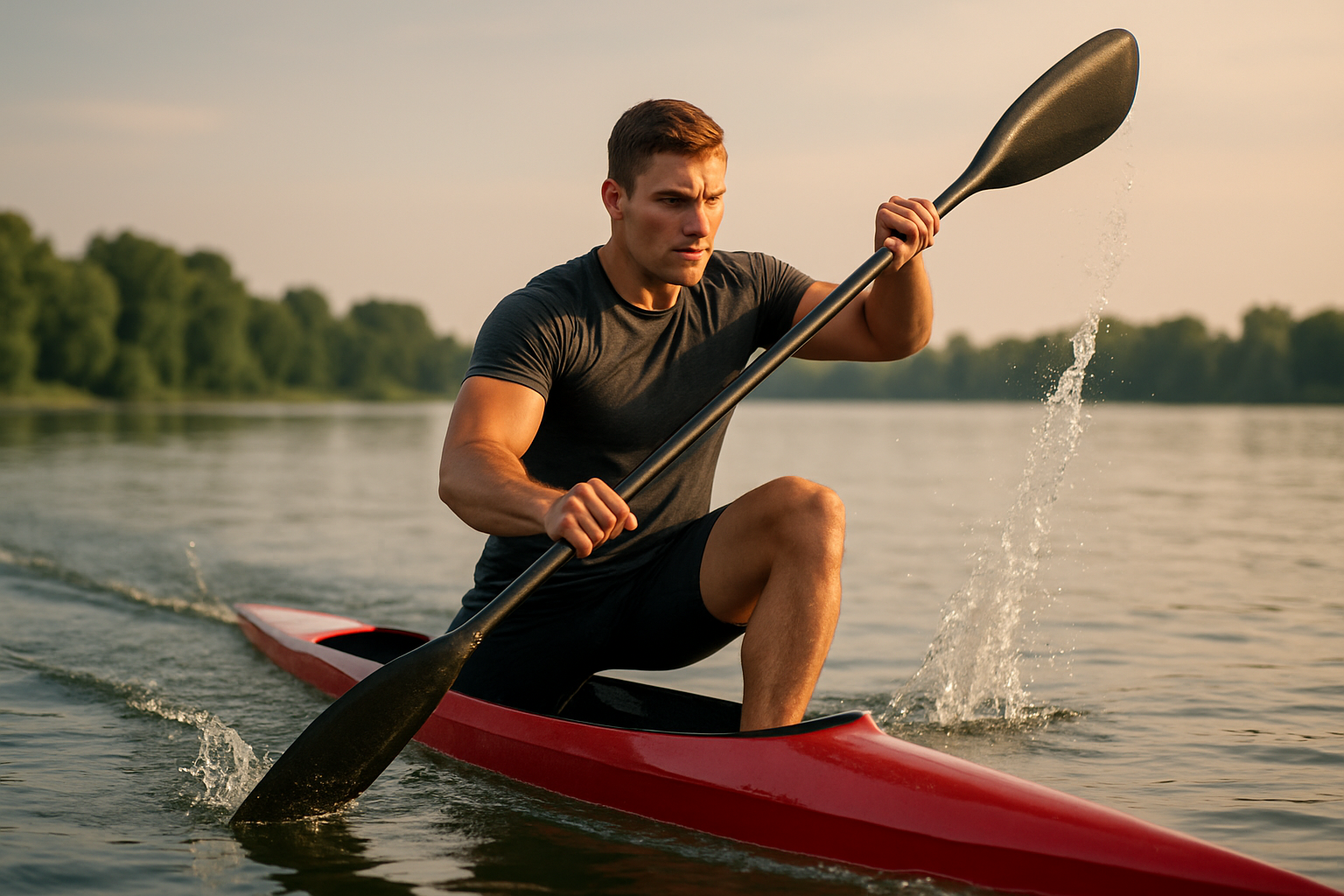The Underappreciated Art of Flatwater Canoe Sprinting
Gliding across a glass-like surface, muscles taut with anticipation, paddlers prepare to unleash a burst of power that will propel them to victory. Flatwater canoe sprinting, a discipline often overshadowed by its whitewater counterpart, combines raw strength, impeccable technique, and unwavering focus. This intense sport demands a unique blend of endurance and explosive power, captivating both athletes and spectators alike.

Initially dominated by European nations, the sport has since seen a global expansion, with countries like Canada, Hungary, and Germany consistently producing top-tier athletes. The evolution of canoe design, paddling techniques, and training methodologies has transformed flatwater sprinting into a highly technical and competitive discipline.
The Mechanics of the Sprint
At its core, flatwater canoe sprinting is about propelling a narrow, streamlined craft through still water as quickly as possible. Athletes compete in single (C1), double (C2), or four-person (C4) canoes, racing over distances of 200, 500, or 1000 meters. The sport demands a perfect synthesis of upper body strength, core stability, and lower body power.
The paddling technique in sprint canoeing is a complex interplay of biomechanics. The stroke begins with the catch, where the paddle enters the water near the athlete’s feet. The power phase follows, with the paddler driving the blade through the water using a rotation of the torso and a push from the top arm. The recovery phase completes the cycle, as the paddle is extracted and returned to the starting position.
Mastering this technique requires years of practice and refinement. Elite paddlers can achieve stroke rates of up to 70 per minute during a race, maintaining precision and power throughout.
Training Regimens: Sculpting the Ultimate Paddler
The training program for a flatwater canoe sprinter is as diverse as it is demanding. Athletes must develop exceptional cardiovascular endurance, explosive power, and sport-specific strength. A typical training week might include on-water technique sessions, high-intensity interval training, long-distance paddles, and land-based strength and conditioning work.
Strength training focuses on developing the muscles crucial for paddling performance, particularly the back, shoulders, and core. Exercises like pull-ups, rows, and rotational movements are staples in a canoeist’s routine. Plyometric exercises help build the explosive power needed for the start and sprint phases of a race.
Endurance work is equally important, with athletes often logging hours on the water to build their aerobic base. This is complemented by cross-training activities such as running, cycling, or swimming to maintain overall fitness and prevent overuse injuries.
The Mental Game: Focus and Strategy in Sprint Canoeing
While physical preparation is crucial, the mental aspect of flatwater canoe sprinting cannot be overstated. Races are often won or lost by fractions of a second, placing immense pressure on athletes to perform under intense scrutiny. Mental toughness, focus, and the ability to manage pre-race anxiety are key attributes of successful sprint canoeists.
Race strategy plays a significant role, particularly in longer events. Athletes must carefully manage their energy expenditure, deciding when to push hard and when to conserve energy. The ability to maintain technique and power output while fatigued is a hallmark of elite paddlers.
Visualization techniques are commonly employed, with athletes mentally rehearsing every aspect of their race, from the start signal to the final stroke. This mental preparation helps build confidence and reduces anxiety on race day.
Technology and Innovation in Flatwater Canoeing
Advancements in technology have revolutionized flatwater canoe sprinting. Modern racing canoes are marvels of engineering, crafted from carbon fiber and other lightweight materials. These vessels are designed to minimize water resistance while maximizing stability and speed.
Paddle design has also evolved, with materials like carbon fiber replacing traditional wooden paddles. The shape and size of paddle blades are carefully optimized to provide maximum propulsion with each stroke.
Biomechanical analysis tools, such as motion capture systems and force measurement devices, allow coaches and athletes to fine-tune technique with unprecedented precision. This data-driven approach to training has led to significant improvements in performance across the sport.
The Global Landscape of Flatwater Canoe Sprinting
While not as widely practiced as some Olympic sports, flatwater canoe sprinting has a dedicated following in many countries. European nations like Hungary, Germany, and Russia have historically dominated the sport, but recent years have seen the emergence of strong programs in countries like China, Brazil, and Cuba.
International competitions, such as the ICF Canoe Sprint World Championships, showcase the sport’s global appeal. These events not only feature elite competition but also serve as important qualifying tournaments for the Olympic Games.
The inclusion of women’s canoe events in the Olympic program for the Tokyo 2020 Games marked a significant milestone in the sport’s history, promoting gender equality and opening up new opportunities for female athletes.
Challenges and Opportunities for Growth
Despite its long history and Olympic status, flatwater canoe sprinting faces challenges in terms of visibility and participation. The sport’s reliance on access to suitable water bodies can limit its growth in some regions. Additionally, the high cost of equipment can be a barrier to entry for aspiring paddlers.
However, these challenges also present opportunities for innovation. Adaptive paddling programs are making the sport more accessible to athletes with disabilities. Community outreach initiatives are introducing canoeing to urban youth, fostering a new generation of paddlers.
The sport’s governing bodies are also exploring ways to make flatwater sprinting more spectator-friendly. Proposals include shorter race formats and the use of technology to enhance the viewing experience, such as real-time GPS tracking and augmented reality displays.
The Future of Flatwater Canoe Sprinting
As the sport continues to evolve, several trends are shaping its future. There is a growing emphasis on sustainability, with efforts to minimize the environmental impact of competitions and training facilities. This includes the development of eco-friendly canoe materials and the promotion of responsible water stewardship.
The integration of data analytics and artificial intelligence in training and performance analysis is expected to accelerate. This could lead to further improvements in technique and race strategy, pushing the boundaries of human performance in the sport.
Efforts to increase the sport’s global footprint are ongoing, with development programs targeting regions where flatwater canoeing is less established. This expansion could bring fresh talent and new perspectives to the international stage.
The Athlete’s Journey: From Novice to Elite
The path to becoming an elite flatwater canoe sprinter is long and demanding. Most successful athletes begin their journey at a young age, often introduced to the sport through family connections or local clubs. The progression from recreational paddling to competitive racing requires dedication, support, and access to quality coaching and facilities.
Junior development programs play a crucial role in nurturing young talent. These programs focus on building a strong technical foundation while fostering a love for the sport. As athletes progress, they may join national training centers or high-performance programs, where they receive specialized coaching and support.
The transition to international competition marks a significant milestone in a canoeist’s career. Success at this level requires not only physical and technical prowess but also the ability to perform under pressure and adapt to varying race conditions.
The Role of Coaching in Flatwater Canoe Sprinting
Coaches in flatwater canoe sprinting wear many hats. They are technicians, strategists, psychologists, and mentors. A great coach can transform raw talent into championship-winning performance through a combination of technical expertise and interpersonal skills.
The coaching process in sprint canoeing is highly individualized. Coaches must tailor training programs to each athlete’s physiology, strengths, and weaknesses. They use a combination of on-water observation, video analysis, and performance data to provide targeted feedback and guide improvement.
Beyond technical instruction, coaches play a crucial role in an athlete’s mental preparation. They help paddlers develop coping strategies for competition stress, set realistic goals, and maintain motivation through the grueling training process.
The Science Behind the Stroke
The biomechanics of flatwater canoe sprinting have been the subject of extensive scientific research. Studies have examined everything from the optimal angle of paddle entry to the role of different muscle groups in generating propulsion.
One area of focus has been the kinetic chain involved in the paddling stroke. Researchers have found that efficient power transfer from the legs through the core to the upper body is key to maximizing speed. This has led to changes in both technique coaching and strength training protocols.
Physiological adaptations in elite paddlers have also been studied. These athletes typically display high levels of upper body strength and aerobic capacity. Understanding these adaptations helps in designing more effective training programs and in talent identification.
Nutrition and Recovery in Flatwater Canoeing
The demands of flatwater canoe sprinting require careful attention to nutrition and recovery. Athletes must fuel their bodies to support intense training while maintaining an optimal power-to-weight ratio.
Meal planning for sprint canoeists often focuses on high-quality proteins for muscle repair, complex carbohydrates for energy, and healthy fats for hormone balance. Hydration strategies are crucial, particularly when training in hot conditions.
Recovery techniques play a vital role in preventing injury and maintaining performance. These may include structured cool-down routines, massage therapy, and the use of compression garments. Many elite paddlers also incorporate practices like yoga or Pilates to improve flexibility and core strength.
The Cultural Significance of Canoeing
While flatwater sprinting is a relatively modern sport, canoeing itself has deep cultural roots in many societies. In countries like Canada and New Zealand, traditional canoe races are important cultural events that connect communities to their heritage.
The sport of flatwater canoe sprinting, in turn, has become a source of national pride for many countries. Success in international competitions can elevate athletes to the status of national heroes, inspiring the next generation of paddlers.
Moreover, the values embodied in the sport - discipline, teamwork, and respect for nature - resonate beyond the competitive arena. Many paddling clubs and organizations use the sport as a vehicle for youth development and environmental education.
Environmental Considerations in Flatwater Canoeing
As a sport intimately connected to water, flatwater canoe sprinting has a unique relationship with the environment. The need for clean, accessible waterways has made the canoeing community strong advocates for water conservation and pollution prevention.
Many canoeing organizations are involved in environmental initiatives, from river clean-ups to habitat restoration projects. These efforts not only benefit the sport but also contribute to broader ecological preservation goals.
Climate change presents both challenges and opportunities for the sport. Rising temperatures and changing precipitation patterns can affect training and competition conditions. However, the canoeing community’s engagement with environmental issues positions the sport as a potential leader in promoting sustainable practices in athletics.
The Economic Impact of Flatwater Canoe Sprinting
While not as commercially prominent as some sports, flatwater canoe sprinting can have significant economic impacts, particularly in regions that host major competitions. International events bring influxes of athletes, support staff, and spectators, boosting local economies.
The sport also supports a niche industry of equipment manufacturers, from canoe builders to paddle makers. Innovations in this sector often have applications beyond competitive paddling, influencing recreational boating and other water sports.
Furthermore, the development of training facilities and competition venues can lead to infrastructure improvements that benefit local communities. Many flatwater canoeing centers also serve as hubs for recreational paddling and water safety education.
Inspiring Stories from the World of Flatwater Canoeing
The history of flatwater canoe sprinting is rich with inspiring stories of perseverance, sportsmanship, and athletic excellence. From athletes who have overcome physical disabilities to compete at the highest level, to paddlers from developing nations who have risen to challenge established powerhouses, these narratives highlight the sport’s capacity to empower and unite.
One such story is that of Laurence Vincent-Lapointe, a Canadian canoeist who faced a potential doping ban that threatened to end her career. Her eventual exoneration and subsequent Olympic medal win in Tokyo 2020 showcased not only her athletic prowess but also her mental resilience.
Another inspiring figure is Nevin Harrison, who became the first American to win gold in canoe sprint at the Olympics, doing so at the age of 19. Her success has sparked renewed interest in the sport in the United States, demonstrating how individual achievements can impact the broader sporting landscape.
The Role of Technology in Training and Competition
Advancements in technology continue to shape flatwater canoe sprinting. GPS-enabled devices allow coaches to track an athlete’s speed, stroke rate, and distance in real-time during training sessions. This data can be analyzed to optimize performance and tailor training programs.
Virtual reality (VR) and augmented reality (AR) technologies are being explored as tools for technique refinement and race simulation. These immersive experiences can help athletes prepare for different race scenarios and conditions without the need for physical travel.
In competition, photo-finish systems capable of measuring to the thousandth of a second ensure accurate results in a sport where races are often decided by the narrowest of margins. Starting systems have also been refined to provide perfectly fair starts, crucial in events where reaction time can make the difference between victory and defeat.
The Intersection of Flatwater Canoeing and Other Disciplines
While flatwater canoe sprinting is a distinct discipline, it shares connections with other paddling sports and athletic pursuits. Many sprint canoeists cross-train in disciplines like marathon canoeing or outrigger canoeing, which can enhance their endurance and technical skills.
The biomechanical principles underlying efficient paddling technique have applications in fields beyond sport, including ergonomics and physical therapy. Research into the mechanics of the canoe stroke has contributed to our understanding of human movement and power generation.
Moreover, the mental strategies employed by elite paddlers - such as focus techniques and performance under pressure - have relevance across various high-stakes professions, from surgery to crisis management.
The Global Community of Flatwater Canoeing
One of the most compelling aspects of flatwater canoe sprinting is the tight-knit global community it fosters. Despite the intense competition on the water, there is a strong sense of camaraderie among athletes from different nations.
International training camps and exchanges are common, allowing paddlers to share knowledge and techniques. These interactions not only improve athletic performance but also promote cultural understanding and friendship across borders.
The sport’s governing body, the International Canoe Federation (ICF), plays a crucial role in nurturing this community. Through development programs, coaching education initiatives, and global events, the ICF works to grow the sport while maintaining its core values of fair play and mutual respect.
Conclusion: The Enduring Appeal of Flatwater Canoe Sprinting
Flatwater canoe sprinting, with its blend of raw power, technical finesse, and strategic thinking, continues to captivate athletes and spectators alike. As the sport evolves, embracing new technologies and expanding its global reach, it remains true to its essence - the pursuit of perfect harmony between paddler, boat, and water.
The challenges faced by the sport - from environmental concerns to issues of accessibility - are met with innovation and dedication by a passionate community of athletes, coaches, and supporters. As flatwater canoe sprinting moves forward, it carries with it a rich history and a bright future, promising continued excitement and inspiration for generations to come.
Whether viewed as a test of athletic prowess, a connection to nature, or a demonstration of human potential, flatwater canoe sprinting stands as a testament to the enduring appeal of aquatic sports. It is a discipline that not only pushes the boundaries of physical performance but also fosters a deep appreciation for the water that sustains us all.





